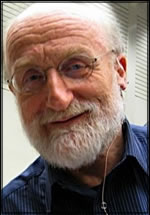2010 ISCB Accomplishment by a Senior Scientist Award Winner – Chris Sander
 |
|
Picture: 2010 ISCB ASSA Winner, Chris Sander
|
The ISCB’s Accomplishment by a Senior Scientist Award is presented annually to a scientist who has made distinguished contributions over many years of research, teaching and service. This year’s award goes to Chris Sander of Memorial Sloan Kettering Cancer Center, New York, USA. He will be presented with his award and deliver a keynote lecture at ISMB 2010 in Boston, on July 12th.
Sander is one of the best-known researchers in protein structure analysis and genomics pathway analysis. Like other founders of bioinformatics, Sander was initially trained as a physicist, with a first degree in physics and mathematics from the University of Berlin in 1967, and a PhD in theoretical physics after graduate studies at the State University of New York, the Niels Bohr Institute in Copenhagen and the University of California in Berkeley. His interest in biology was first kindled by Joe Franklin, a research chemist, during a high school exchange year in Texas. At the age of 21, he went straight to the top to explore this interest, took a trip to Caltech and knocked on the door of Max Delbrück, a physicist turned pioneering bacterial geneticist. Delbrück elaborated on the potential of theoretical physics in molecular biology, but it was not until after completing his first postdoc in theoretical high-energy nuclear physics in Heidelberg that Sander made the lateral transition to biology.
Sander chose to work on protein folding because, as he said with a smile, "I liked stereo views of molecules". He became a post-doc with Shneior Lifson, then a leader in the field of molecular force fields for biopolymers at the Weizmann Institute in Israel. "Lifson taught me that the most important skill in science is to ask good questions," Sander says with admiration.
Having successfully switched from theoretical physics to biology, he then moved to the Max-Planck Institute for Biophysics in Heidelberg to work with Georg Schulz, a protein crystallographer, and biophysicist Ken Holmes. His first independent collaboration with post-doc colleague Wolfgang Kabsch led to the development of the algorithm for analyzing protein structures, DSSP, that 17 years later is still used as a standard for identifying protein secondary structures in experimental 3D structures.
In 1986, Sander took a giant leap from senior post-doc to department chair and founder of the Biocomputing Program at the European Molecular Biology laboratories (EMBL) in Heidelberg, with the support of Sydney Brenner, one of the grand masters of molecular biology. "EMBL is an ideal environment for young, independent scientists to flourish", he says. "It is highly stimulating, collaborative and international." During that period he also pursued his dream of building international collaborations and a worldwide bioinformatics infrastructure as active co-founder of the European Molecular Biology Network (EMBnet). When, in 1995, EMBL moved its bioinformatics research and services from Heidelberg to the European Bioinformatics Institute (EMBL-EBI) in Cambridge, UK, he joined the new institute as a group leader. Soon thereafter he was a founding member of the Board of Directors of ISCB when the society was established in early 1997.
By the late 1990s Sander was motivated by "having more impact in the real world than can be afforded by publications and conferences. While a guest at the MIT Genome Center in Cambridge, Massachusetts in 1998, he co-founded the bioinformatics company Millennium Information, a short-lived spinout from Millennium Pharmaceuticals. Recruited by Harold Varmus, in 2002 Sander accepted the challenge to found his second department of computational biology, now at Memorial Sloan-Kettering Cancer Center in New York, with strong emphasis on translational, i.e., clinically relevant, techniques and applications, particularly in cancer medicine.
Sander predicts about his own work: "the best is yet to come". He is continuing to innovate, and expects to present new results in his keynote lecture at ISMB 2010, describing a novel approach to cell biology that builds network models based on systematic perturbation of the cellular system and rich observation of the resulting changes in molecules and cellular phenotypes. "We rapidly cycle between experiment and theory and I now have a wet lab in my group for the first time in my career", he says.
Sander reflects, "The two key ingredients for successful science are asking good questions and working with good people in a friendly atmosphere. The results of my past and present work are in essence the product of my collaborations with scientists across varied disciplines and from many countries, and I am their fan."
>>Return to List of ASSA Recipients
